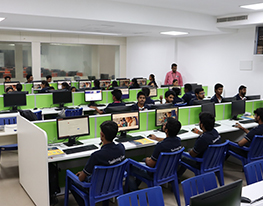| S.No | Name of the project | Abstract |
| 1 | PAINTING TOMORROW’S CANVAS: ARTISTIC INSIGHTS INTO SALES PREDICTION | They proposed research introduced a sophisticated web-based platform meticulously designed for predicting sales outcomes by leveraging historical sales data and integrating advanced machine learning algorithms. The platform boasts a user friendly interface, incorporating login, sign up, and input gathering pages to ensure a seamless and interactive user experience. Beyond predictive analytic, paramount importance has been placed on the security aspects of the application, with a specific focus on cyber security measures to safeguard business data. The system, fortified against potential threats such as man-in-the-middle attacks, denial-of- service attacks, and rainbow table attacks, showcases intuitive technologies that fortify the application against malicious activities. Through the application of cutting- edge algorithms, the system analyzes patterns and trends within historical sales data, providing users with invaluable insights to fine-tune and optimize sales strategies. Develop a web- based platform capable of accurate 98% predicting sales outcomes and create a user-friendly interface that enhances the overall user experience and that can be accessed by a common man. prioritize the security aspects of the application. and showcase intuitive technologies that fortify the application against malicious activities. |
| 2 | ALGORITHMIC TRADING STRATEGIES FOR FINANCIAL MARKETS | This project focuses on providing algorithmic trading strategies tailored for financial markets. It offers an accessible and comprehensive guide aimed at both beginners and enthusiasts interested in algorithmic trading.The project covers various stages ofalgorithmic trading, starting with data collection and preprocessing. Techniques for handling financial data, including cleaning, normalization, and feature extraction, are explored to ensure the data is suitable for modeling. Next, a variety of machine learning and statistical models are applied to develop trading strategies. Techniques such as time series analysis, regression, and classification are utilized to forecast market trends, identify trading signals, and manage risk. The model stands at 81.06%, showing improvement from the previous accuracy of 79.22%.Furthermore, the project explores the deployment of trading strategies in Real-world trading environments. Considerations such as transaction costs, slippage, andmarket impact are addressed to ensure practical implementation. The final Deliverable includes a selection of well-performing trading strategies, along withguidelines for their implementation and deployment. such as NumPy, Pandas, Scikit-learn, TensorFlow, and Keras for mmodel stands at 81.06%, showing improvement from the previous accuracy of 79.22%.Furthermore, the project explores the deployment of trading strategies in real-world trading environments. Considerations such as transaction costs, slippage, andmarket impact are addressed to ensure practical implementation. The final deliverable includes a selection of well-performing trading strategies, along withguidelines for their implementation and deployment. Additionally, the project provides insights into ongoing research and developments in algorithmic trading, fostering continued exploration and innovation in this dynamic field.The project utilizes For the web application deployment, frameworks like Flask or Django are considered, with platforms like Heroku or AWS for hosting. By offering a detailed and beginner- friendly approach to algorithmic trading strategies, this project aims to empower individuals with the knowledge and tools to navigate financial markets effectively and strategically. This report is a detailed discussion of how we achieved a higher accuracy, what techniques were used and some samples screenshots of how it mightget implemented in the real-world. |
| 3 | Finetuning LLMs for work satisfaction prediction | This paper explores the fine-tuning of large language models (LLMs) for analyzing employee sentiments and predicting work satisfaction scores based on likes and dislikes. We compare the performance of Gemma-2B by Google and TinyLlama-1.1B, both fine-tuned using a dataset containing employee feedback parameters. The fine-tuning process involves adapting the models to the task at hand, with a focus on parameter-efficient fine-tuning methods to optimize performance while minimizing resource usage. Our results demonstrate that Gemma 2B outperforms TinyLlama-1.1B in terms of training loss and accuracy, indicating its suitability for analyzing employee sentiments. Furthermore, we highlight the importance of model quantization for de ployment on lower-end GPUs, enabling wider accessibility and scalability of sentiment analysis systems. In conclusion, our research provides valuable insights into the effective utilization of large language models for improving workplace satisfaction and suggests avenues for future research in sentiment analysis and model optimization. |
| 4 | Revolutionizing Sales- High impactful performance optimizing dashboard | In the contemporary business landscape, where markets are dynamic and consumer preferences are ever-evolving, the optimization of sales performance stands as a pivotal challenge for organizations across industries. This final year project endeavors to address this challenge by employing a comprehensive, data-driven methodology to enhance sales efficiency and effectiveness. The project will commence with an in-depth exploration of various sources of sales-related data, encompassing customer demographics, purchasing histories, product preferences, and market trends. Leveraging advanced data analytics techniques, including machine learning algorithms and predictive modeling, these datasets will be analyzed to unearth latent patterns, correlations, and potential opportunities for optimization. |
| 5 | SENTIMENTAL ANALYSIS OF ONLINE PRODUCT REVIEWS USING BERT | The utilization of the BERT neural network model in evaluating emotions from online product reviews has demonstrated its effectiveness in enhancing the comprehension of customer preferences on online products. This approach not only aids platforms in better addressing customer needs but also assists Customers in identifying suitable and budget- friendly Products. This advancement contributes to the refinement of product recommendations through intelligent processing. By harnessing the pretrained BERT model, a series of experiments were conducted involving sentiment analysis. Through meticulous parameter adjustments throughout the experimentation phase, a highly accurate classification model was developed. The BERT layer was employed as a foundational word vector layer. Input text sequences were fed into this layer to undergo vector transformation. The resulting vectors, upon passing through corresponding neural networks, underwent classification via the SoftMax activation function. Sentiment analysis involves assessing the attitudes of customers based on textual data, particularly product reviews in this case. Through this study, we developed a solution capable of determining sentiments expressed in online product reviews. To achieve this, we employed algorithms such as Logistic Regression, Random Forest Classifier, and Sentiment Intensity Analyzer. The experimental outcomes illustrate the achieved accuracy in performing sentiment analysis. |
| 6 | Predictiomate: Enabling small business empowerment through intuitive data analysis solutions | “Predictiomate” revolutionizes small business data analysis with its user-friendly web platform. Unlike traditional tools like Weka, it supports various file formats like CSV and Excel, eliminating the need for specific formatting. This flexibility streamlines data uploading and analysis, empowering users to extract insights without technical hurdles. By democratizing data analysis, Predictiomate equips small business owners to make informed decisions, enhancing their competitiveness. Its intuitive interface and versatile functionality make it accessible to all users. Bridging the gap between data and decision-making, Predictiomate simplifies complex analyses for small businesses. Through its user-friendly features and file format support, it levels the playing field in data- driven environments. In essence, Predictiomate is a groundbreaking tool, offering accessible yet comprehensive data analysis for small businesses. It empowers users with the insights needed to thrive in the digital age, revolutionizing decision-making processes. |
| 7 | BITCOIN SENTIMENT ANALYSIS USING TWITTER | Bitcoin has recently gained substantial attention as a highly coveted asset, particularly among younger demographics attracted by its potential for significant returns and the revolutionary promise of blockchain technology. This surge in interest has led to the proliferation of self-proclaimed “experts” in cryptocurrencies and blockchain, further driving the widespread adoption of digital assets. Consequently, institutional investors and “smart money” are increasingly focusing on Bitcoin, employing various strategies to accurately forecast its price movements. Among these strategies, sentiment analysis has emerged as a key tool for predicting Bitcoin’s price trajectory. Hedge funds, investment banks, and other market participants meticulously analyze social media platforms to glean insights into public sentiment surrounding Bitcoin and related subjects, with Twitter being a valuable source of real-time sentiment data due to its extensive user base and open nature. This project aims to leverage sentiment analysis techniques and deep neural networks to predict Bitcoin’s price based on sentiment trends observed on Twitter. By analyzing sentiments expressed in Bitcoin-related tweets, the proposed deep learning models seek to uncover patterns and correlations that may provide valuable insights into future price movements, ultimately enhancing the accuracy and reliability of Bitcoin price predictions. |
| 8 | RESUME SCREENING AND CONTACT EXTRACTION SYSTEM | Resume Screening is the process of evaluating the resume of the job seekers based on a specific requirement. It is used to identify the candidate eligibility for a job by matching all the requirements needed for the offered role with their resume information such as education qualification, skill sets, technical stuff etc. Resume Screening is a crucial stage in candidate’s selection for a job role, it is the stage where the decision making is done whether to move the candidate to the next level of hiring process or not. Traditionally, this process is performed manually, but companies often receive thousands of resumes for job applications. In order to reduce the human involvement and errors, many new ways were introduced in this process. This paper discusses about one such process which is very efficient in performing Resume screening. It includes Natural Language Processing (NLP), an automated Machine Learning Algorithm for screening the resumes. This paper explains the end to end working of a python application which efficiently screens the resumes of the candidates based on the organization’s requirement. |
| 9 | Online resume builder application with integrated audio recorder | The Resume Builder Application is a user-friendly and efficient tool that helps users create professional resumes. The application is designed to simplify the resume-building process, allowing users to create a resume quickly and easily. The application is based on a web-based platform, which means that users can access the application from any device with an internet connection. The application’s main features include a user-friendly interface, pre-designed resume templates, and the ability to customize each template to fit the user’s needs. The application also includes a resume editor, allowing users to add and delete sections and customize the font and color of their resume. The Resume Builder Application also includes a range of resources to help users create the best possible resume. These resources include tips and tricks for writing a successful resume, a list of action verbs to use in resumes, and examples of well-written resumes. The application is designed to be a one-stop-shop for users looking to create a professional resume quickly and efficiently. In conclusion, the Resume Builder Application is a user-friendly and efficient tool that simplifies the resume-building process, providing users with pre-designed templates and resources to help them create professional resumes. |
| 10 | Timeflow employee task management system | Time Flow is a web-based employee task manage ment system designed to streamline organizational workflows. It offers features for task assignment, progress tracking, and collaboration. Time Flow enhances productivity by providing a user-friendly interface and scalable architecture. This paper explores the system’s design, functionalities, and advantages. Through case studies and user feedback, we demonstrate its effectiveness in optimizing task management processes within organizations. |
| 11 | STOCK MARKET PREDICTION USING MACHINE LEARNING ALGORITHMS | This project is an attempt at implementing Python a technique for forecasting stock values. Python has been successfully used to predict stock prices. To help investors make more informed and precise investment decisions, stock price forecasting is done. We propose an approach that integrates mathematical operations, machine learning, and other external aspects to enhance stock price forecast accuracy and produce profitable trades. LSTMs are very good at handling problems with sequence prediction because they can store past data. In our case, this is crucial since examining a stock’s historical price can assist anticipate its future price. You can develop a model that forecasts whether the price of a stock will climb or fall while also forecasting that the actual price of the stock will increase. |
| 12 | The ultimate time mastery suite for seamless workforce management | This paper presents a comprehensive system for user authentication, password management, two-factor authentication setup, employee and admin dashboards, timesheet management, and scoreboard history within an organizational framework. Users, including administrators and staff, have the capability to register and log in, with the option for admin status indication. Enhanced security measures such as password reset functionality and two-factor authentication are implemented. Employee dashboards facilitate efficient timesheet management, while admin dashboards offer advanced data analysis capabilities. Timesheets are presented in a structured format allowing for easy viewing, editing, and submission. Scoreboard history functionality enables users to track performance over time. The proposed system enhances organizational efficiency and security by providing streamlined user management and robust data analysis tools. |
| 13 | Optimizing financial risk profiling through machine learning: A comprehensive approach to credit risk assessment | This report examines financial risk profiling, focusing on credit risk analysis to improve understanding of creditworthiness and support informed lending decisions. Utilizing the South German Credit dataset, it conducts exploratory data analysis (EDA) to reveal insights into credit risk distribution, credit amount tendencies, age demographics, and feature correlations. The study evaluates multiple machine learning (ML) models, highlighting the Random Forest model’s notable accuracy of 85% in predicting credit risk. The findings offer practical insights for banks and financial institutions, advocating for the integration of predictive models into risk assessment frameworks to enhance credit risk management. This approach not only promotes responsible lending practices but also contributes to long-term financial sustainability and stability in the banking sector. |
| 14 | ASSERT ALLOCATION USING MACHINE LEARNING | In this research, we introduce a new way to optimize portfolios by combining two powerful techniques: sentiment analysis of financial news headlines and multi-asset portfolio optimization using the Capital Asset Pricing Model (CAPM). Our approach blends quantitative analysis with a qualitative assessment of sentiment, allowing us to build portfolios that are both diversified and sensitive to market sentiment. By incorporating multiple assets into our optimization framework, we are able to construct portfolios that better reflect real-world investment scenarios. Our study showcases how this integrated approach can improve investment decision-making by considering both market sentiment and asset pricing models. |
| 15 | Cybernetic financial prediction: Quantum forecast analysis for market dynamics: ( stock prediction) | In the ever-evolving landscape of financial markets, accurate prediction of stock market trends remains a paramount challenge. This abstract introduces a cutting-edge approach to this challenge, termed “Forecast Analysis for Stock Market Dynamics.” Leveraging advanced computational techniques and harnessing the power of artificial intelligence, this innovative methodology transcends traditional market analysis. The core of this approach lies in the integration of cybernetic principles and quantum computing capabilities. By assimilating vast datasets and real-time market information, the model attains a level of financial sentience, allowing it to adapt dynamically to changing market conditions. Quantum algorithms further enhance predictive accuracy, navigating the intricate web of financial variables with unparalleled speed and precision. This advanced forecast analysis system not only provides investors with predictive insights but also offers risk assessments and scenario analyses, empowering decision makers with a comprehensive understanding of potential market trajectories. As financial markets become increasingly interconnected and influenced by diverse factors, this holistic approach to stock market dynamics heralds a new era in predictive analytics, offering a robust tool for informed decision-making in the complex world of finance. |
| 16 | COLLABORATIVE CODE EDITOR WITH VIDEO CONFERENCING AND FACE DETECTION FOR INTERVIEWS | In the ever-evolving times of software development, the adoption of effective coding practices and collaborative techniques stands as a cornerstone for seamless progress. The ability to work harmoniously and exchange ideas in real-time not only enhances teamwork but also fosters innovation within teams. Moreover, the integration of instant feedback mechanisms ensures a continuous cycle of improvement, thereby maintaining the standards and quality of code throughout the development lifecycle. Against this backdrop of technological advancement, recent innovations have yielded powerful tools that hold promise for constructing robust solutions. Among these, CodeMirror provides an intuitive platform for code editing, while Peer.js harnesses the capabilities of WebRTC to facilitate peer-to-peer connections. Additionally, advancements in facial recognition technology, such as FaceAPI, offer opportunities for real- time monitoring and analysis. |

















 Quick Links
Quick Links
